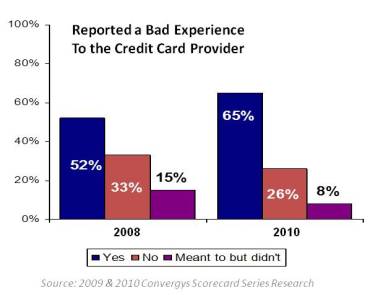Even with all the publicity surrounding last year’s Dodd-Frank financial-reform legislation and the pending Durbin Amendment fee controls, the public doesn’t generally differentiate between the major card networks (Visa, MasterCard), bank-issued cards, or the processing networks behind these. But the cumulative effect of the hype has been to make card holders generally suspicious. More than customers in any other industries, financial services customers want to trust and to be loyal. Good service goes a long way towards achieving this, but bad service can quickly validate their fears. Unfortunately, the latter scenario seems to be playing out in today’s marketplace.
Today we’ll look at customer experience with credit card issuers according to the 1,900 U.S. consumers surveyed as part of the research I directed last year http://bit.ly/oDzXg8. Here’s a short list of differences between customer experience with card providers and with other industries aggregated:
- Whereas 70% of banking customers say they are loyal, just 54% of card holders said they were loyal to their credit card provider (avg=57%). Interestingly, employees of those providers incorrectly predicted 83% were loyal (the highest prediction of all verticals).
- Just 65% of card holders think providers offer the right service channels. The
strongest channel: self-service web sites (78% sat). Weakest channels: live
phone support (55% sat) and email (50% sat). Channels cardholders would like to see improved: automated phone system (68% sat), live web chat (67% sat), and in-person visits (64% sat). - Just 63% of customers reported satisfaction with their most recent service experience (the second lowest of all industries) and 20% reported dissatisfaction (the highest of all industries). 64% reported dissatisfaction when terminating an account and 51% when submitting a complaint.
- 44% of surveyed customers recalled a recent bad experience with a card provider (average 43%). (34% Seniors, 46% Boomers, 49% Gen-X, 33% Millennials). The primary reasons: rude employees (54%) and multiple attempts to get resolution (51%).
- 65% of customers reported their bad experience to the provider (average 66%), up from 52% in 2008. 26% said their issue was resolved, but 42% still defected (average=30%). 54% said their issue was not resolved, and 66% defected if issue was not resolved (average=50%). 80% defected if they no response from provider, which happen in 21% of the time. This represents the highest defection rate of all verticals in cases where a bad experience has been reported and ignored.
- Men are much more likely to report a bad experience (70% of men, 61% of women), and to change providers if they don’t get a response (89% of men, 57% of women).
- Generational differences are more pronounced in the credit card industry. Millenials are the most forgiving demographic group, perhaps because credit is more difficult for them to obtain. Whereas just 48% of Baby Boomers report being loyal (82% for Banks), 64% of Millennials say they are loyal. This comes despite service poor service levels for younger customers: 75% of Millenials said that a rude employee was the cause of their most recent bad experience. Yet, of those who reported a bad experience and got no resolution, NO Millenials defected (vs. 69% of Boomers).
- Employee preparedness to deliver good customer service has declined by 5% since 2008. The primary reasons: 71% of front-line employees are empowered to
resolve customer’s problems (down from 78%), and 67% have access to all of the
customer data they need (down from 73%).
Conclusions: Credit card customers are putting up with a lot, and they are not happy about it. Constant bad press gives them reason to be suspicious, and service levels and issue resolution are declining. One of the most telling stats is that 21% of the time customers get NO response at all to a reported issue. Consequently, loyalty is declining – except amongst the Millenials, who are grateful to get credit when they can. Boomers on the other hand – especially men – are more likely to defect after being ignored than customers in any other industry. Seems that many credit card customers are displeased, and the ones who have choices are acting upon them. If service levels don’t improve, the younger customers will forget their loyalty once they have choices. Can any business afford to alienate current and future customers?




